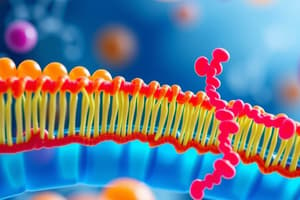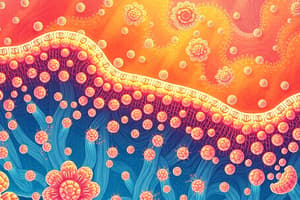Podcast
Questions and Answers
What role do transport proteins play in cellular membranes?
What role do transport proteins play in cellular membranes?
Which characteristic of phospholipids contributes to the formation of a cell membrane?
Which characteristic of phospholipids contributes to the formation of a cell membrane?
In the fluid mosaic model of the plasma membrane, what is meant by 'fluid'?
In the fluid mosaic model of the plasma membrane, what is meant by 'fluid'?
What is selective permeability in relation to the plasma membrane?
What is selective permeability in relation to the plasma membrane?
Signup and view all the answers
What could happen to a cell placed in a hypertonic solution?
What could happen to a cell placed in a hypertonic solution?
Signup and view all the answers
What is the primary characteristic of a transport protein?
What is the primary characteristic of a transport protein?
Signup and view all the answers
In which direction do molecules typically diffuse?
In which direction do molecules typically diffuse?
Signup and view all the answers
What does dynamic equilibrium signify in the context of diffusion?
What does dynamic equilibrium signify in the context of diffusion?
Signup and view all the answers
How does water move during osmosis?
How does water move during osmosis?
Signup and view all the answers
What is the result of substances diffusing down their concentration gradient?
What is the result of substances diffusing down their concentration gradient?
Signup and view all the answers
What is a selectively permeable membrane?
What is a selectively permeable membrane?
Signup and view all the answers
What principle governs the movement of water across a membrane?
What principle governs the movement of water across a membrane?
Signup and view all the answers
Which statement correctly describes passive transport?
Which statement correctly describes passive transport?
Signup and view all the answers
Which type of molecules can pass through the lipid bilayer rapidly?
Which type of molecules can pass through the lipid bilayer rapidly?
Signup and view all the answers
What is the role of transport proteins in the plasma membrane?
What is the role of transport proteins in the plasma membrane?
Signup and view all the answers
Which channel protein is specifically known for facilitating the passage of water?
Which channel protein is specifically known for facilitating the passage of water?
Signup and view all the answers
What characterizes a selectively permeable membrane?
What characterizes a selectively permeable membrane?
Signup and view all the answers
What effect does a hypotonic solution have on a cell?
What effect does a hypotonic solution have on a cell?
Signup and view all the answers
How do hydrophilic substances typically cross the plasma membrane?
How do hydrophilic substances typically cross the plasma membrane?
Signup and view all the answers
What happens to a cell in an isotonic solution?
What happens to a cell in an isotonic solution?
Signup and view all the answers
Which of the following best describes the selective permeability of the plasma membrane?
Which of the following best describes the selective permeability of the plasma membrane?
Signup and view all the answers
Study Notes
Membrane Structure and Function
- The plasma membrane separates the living cell from its surroundings
- The plasma membrane is selectively permeable, allowing some substances to cross it more easily than others.
- Transport proteins are often responsible for controlling passage across cellular membranes.
Fluid Mosaic Model
- The membrane is a mosaic of protein molecules bobbing in a fluid bilayer of phospholipids.
- Proteins are not randomly distributed in the membrane.
- Phospholipids are amphipathic molecules, meaning they have both hydrophobic (water-fearing) and hydrophilic (water-loving) regions.
- Hydrophobic tails are sheltered inside the membrane while hydrophilic heads are exposed to water on either side.
Membrane Proteins
- Peripheral proteins are bound to the surface of the membrane.
- Integral proteins penetrate the hydrophobic core.
- Transmembrane proteins span the membrane.
- The hydrophobic regions of integral proteins consist of one or more stretches of nonpolar amino acids.
Membrane Carbohydrates
- Cells recognize each other by binding to molecules often containing carbohydrates on the extracellular surface of the plasma membrane.
- Membrane carbohydrates may be covalently bonded to lipids (forming glycolipids) or more commonly to proteins (forming glycoproteins).
- Carbohydrates on the extracellular side of the plasma membrane vary among species, individuals, and cell types.
Membrane Fluidity
- Membranes are mostly held together by hydrophobic interactions, and most of the lipids and some proteins can move sideways within the membrane.
- Rarely a lipid may flip-flop across the membrane.
- Membranes must be fluid to work properly.
- The fluidity of membranes depends on the types of lipids, especially if they are saturated or unsaturated fatty acids.
- Cholesterol affects membrane fluidity at different temperatures; Restrains movement at warm temps and prevents tight packing at cooler temps.
Cell-Surface Proteins
- Cell-surface proteins play roles in transport, enzymatic activity, signal transduction, cell-cell recognition, intercellular joining, attachment to the cytoskeleton and extracellular matrix (ECM).
- HIV uses the cell-surface protein CCR5 in order to infect a cell.
Passive Transport
- Diffusion is the tendency of molecules to spread out evenly into available space.
- At dynamic equilibrium, as many molecules cross the membrane in one direction as in the other.
- Substances diffuse down their concentration gradient.
- No work is required to move substances down their concentration gradient, this is "passive transport".
- Osmosis is the diffusion of water across a selectively permeable membrane
Toncity
- Tonicity is the ability of a surrounding solution to cause a cell to gain or lose water.
- Isotonic solution: Solute concentration is the same as inside the cell.
- Hypertonic solution: Solute concentration is greater than inside the cell; cell loses water.
- Hypotonic solution: Solute concentration is less than inside the cell; cell gains water.
- Cells without cell walls will shrivel in hypertonic solution and lyse (burst) in a hypotonic solution.
- Cells with cell walls will become turgid (firm) in a hypotonic solution, and flaccid (limp) in an isotonic solution. A hypertonic solution will cause the cell to plasmolyze (wilt)
Active Transport
- Active transport uses energy, usually in the form of ATP hydrolysis, to move substances against their concentration gradients.
- All proteins involved in active transport are carrier proteins.
- The sodium-potassium pump is a major electrogenic pump in animal cells.
- The proton pump is the main electrogenic pump in plants, fungi, and bacteria.
Cotransport
- Cotransport occurs when active transport of a solute indirectly drives transport of other substances.
- The diffusion of an actively transported solute down its concentration gradient is coupled with the transport of a second substance against its own concentration gradient.
Bulk Transport
- Bulk transport across the plasma membrane occurs by exocytosis and endocytosis.
- Small molecules and water enter or leave the cell through the lipid bilayer or via transport proteins.
- Large molecules, such as polysaccharides and proteins, cross the membrane in bulk via vesicles.
Endocytosis
- In endocytosis, the cell takes in macromolecules by forming vesicles from the plasma membrane.
- Endocytosis is the reversal of exocytosis.
- There are three types of endocytosis: phagocytosis (cellular eating), pinocytosis (cellular drinking), and receptor-mediated endocytosis.
- In phagocytosis, a cell engulfs a particle in a vacuole.
- In pinocytosis, molecules dissolved in droplets are taken up when extracellular fluid is "gulped" into small vesicles.
- In receptor-mediated endocytosis, binding of specific solutes to receptors triggers vesicle formation.
- Human cells use receptor-mediated endocytosis to take in cholesterol, which is carried in particles called low-density lipoproteins (LDLs).
Studying That Suits You
Use AI to generate personalized quizzes and flashcards to suit your learning preferences.
Related Documents
Description
Test your knowledge on the essential roles of transport proteins and the properties of phospholipids in cellular membranes. This quiz covers topics such as selective permeability, diffusion, and osmosis, providing a comprehensive overview of the fluid mosaic model of plasma membranes. Perfect for students studying cellular biology.




